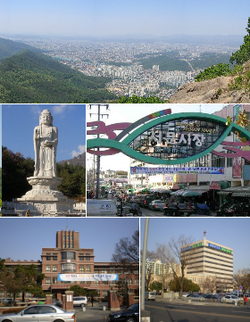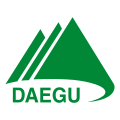Daegu
Daegu (대구, also spelled Taegu, officially called Daegu Metropolitan City) is a city in South Korea. It is between Seoul and Busan, but is closer to Busan. Daegu is the fourth largest city in South Korea. About 2.4 million people live in Daegu. Of South Korea's 16 cities and provinces, Daegu is the poorest in terms of GDP per capita 2010 at $18,887 according to the IMF. However, Suseong district , is one of the wealthiest districts in the nation. It is also renowned for ultracompetitive and mostly gender-segregated public high schools, following closely the School District Eight in Gangnam and Seocho with their performance. Therefore, the wealth disparity within the city is wider than many other cities in Korea. For example, even though Daegu has the lowest GDP per capita, Daegu has the third largest percentage of residents who has the net asset higher than 1 Billion KRW, following Seoul and Busan and followed by Gyeonggi Province. Suseong district topped all other districts in metropolitan areas, minus Seoul.[2]
|
대구 大邱 | |
|---|---|
| Daegu Metropolitan City | |
| transcription(s) | |
| • Hangul | 대구광역시 |
| • Hanja | 大邱廣域市 |
| • Revised Romanization | Daegu-gwangyeoksi |
| • McCune-Reischauer | Taegu-kwangyŏksi |
 | |
 Map of South Korea with Daegu highlighted | |
| Country | |
| Region | Yeongnam |
| Districts | 7 |
| Government | |
| • Mayor | Joonpyo, Hong (홍준표) |
| Area | |
| • Total | 884.15 km2 (341.37 sq mi) |
| Population (2009)[1] | |
| • Total | 2,512,604 |
| • Density | 2,842/km2 (7,360/sq mi) |
| • Dialect | Gyeongsang |
| Flower | Magnolia |
| Tree | Fir |
| Bird | Eagle |
| Website | daegu.go.kr (in English) |
Daegu residents are also regarded by all other South Koreans as the widely ultraconservative.
History
In 1995, 101 people were killed by gas explosions. In 2003, 192 people were killed in a subway fire.
Climate
Daegu has a humid subtropical climate (Cwb in the Koeppen climate classification). Summer is hot, with very high rainfall.[3][4] Daegu is one of the hottest cities in Korea.[5] Winters are dry and cool.
Popular places
Palgong Mountain is north of Daegu. It is famous for Donghwa Temple and Gatbawi. Gatbawi is a statue of Buddha. Apsan(Ap Mountain), also called Daedeok Mountain has many well known restaurants. It is a good place to hike. Many hikers visit the Apsan Mountain. The downtown area of Daegu is Dongseongro. There is a festival every year in June. It also is the shopping center of Daegu. Woobang Tower Land is an amusement park with many rides and roller coasters. Daegu is also famous for having Daegu Stadium where the World Cup tournament was held in 2002.
Culture
Daegu was the known for apples in Korea before 1990. Daegu has a herbal medicine market located in a street 1 kilometre long. The textile (cloth) industry was the primary industry from the 1960s but has seen drastic decline to the present day.. People in Daegu enjoy food. One example is ddeokbokki. Ddeokboki is a Korean rice cake with spicy red pepper sauce and vegetables. Foods in Daegu are usually more spicy and salty than in other cities.
Daegu is widely regard by majority of Koreans and its own residents as the most conservative in its approach to values and life. A fact that is widely broad up and which all of Daegu people are proud of. Every district within the city shares a similar theme in its collection of business- Phone Retails Shops, Ghim-bab cheap food shops, plant shops, Paris Bagguette or Tour Les Jours chain bakeries, Karaoke dens which sometimes double as "good-time" business clubs, family owned and operated pharmacies, Korean Barbecue eateries.
Non-Korean citizens do not open businesses of any size within the city because city legislation dictates that two or more Koreans are required be partnered to the businesses. The effect is every functioning business is owned and envisioned solely by a South Korean national.
Unlike more famous cities such as Seoul or Busan, there is a single, homogeneous dominant culture in Daegu - Right-wing orthodox South Korean ultra-conservatives.
Foreign nationals form only three classes of long-term residents: In descending numbers: (1) US Army personnel and their families garrisoned within three giant military bases located in Daegu. (2) Immigrant workers typically from Uzbekistan and Philippines hired to labour cheaply in Seo-Gu factories (all of West Daegu). (3) Foreign English teachers from the USA or UK clustering together. The white-skinned is held by local Daegu beliefs in improved teaching quality derived, and also a point of bragging to others - a popular Daegu boast, "My son has a white-skinned English teacher.".
Short-term residents: (1) Japanese & Chinese National exchange or language students (closest neighbours) who will find the racial climate: emotional & touchy. Japanese: averages 3 to 4 months before permanent departure. Chinese: 7–9 months before permanent departure, or VISA expiration and deportation. (2) Adventurous backpackers passing through for two days as they tour the Korean Peninsula.
Daegu Media
Reliquary from eighth-century Silla, Daegu National Museum
References
- ↑ National Statistical Office (2009). "행정구역(동읍면)별 인구, 가구 및 주택". Retrieved 2008-12-31.[dead link]
- ↑ "대구, 금융자산 10억 이상 12200명·". 대구신문 (in 한국어). 2018-08-06. Retrieved 2022-04-21.
- ↑ "Average Weather in Daegu, South Korea, Year Round - Weather Spark". weatherspark.com. Retrieved 2020-07-18.
- ↑ 대구 통계 연보. 대구시. 1972.
- ↑ "Hottest morning in 111 years gripped Korea: data". koreatimes. 2018-07-23. Retrieved 2020-07-18.








